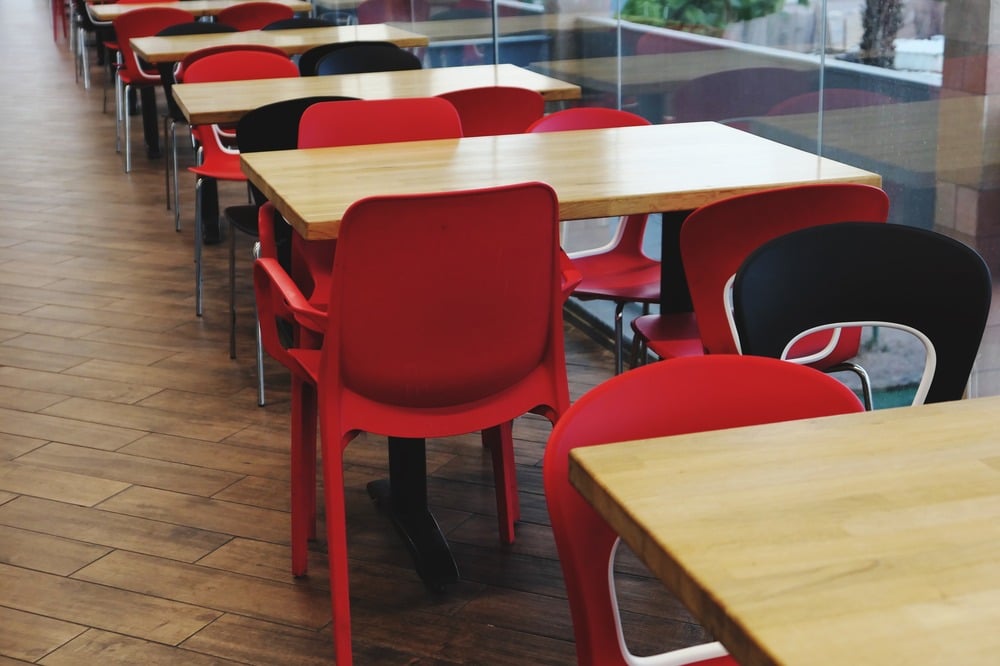Support Student Health and Comfort with School Dining Furniture
Nov 21, 2024 • 5 minutes

Schools have many responsibilities toward their students, from providing the best learning opportunities to supporting their well-being and personal growth. A large part of creating a positive environment for learning, socialising and relaxation involves choosing comfortable, accessible seating.
While ergonomic design is often prioritised in classrooms to help students stay focused and engaged, the dining hall deserves just as much attention. Dining tables may only be used for a short period each day, but their impact is far from insignificant. In fact, dining furniture plays a surprisingly critical role in supporting students’ physical health, comfort and academic performance. So, what makes the right dining furniture so essential?
What is Ergonomics?
Ergonomics, in the simplest terms, is all about designing environments with the user’s comfort, health and well-being in mind. It is not limited to individual pieces of furniture like chairs or tables, it includes how entire spaces are arranged, how lighting and acoustics are managed and even how daily schedules are structured.
In schools, ergonomics considers how various elements affect students’ comfort and their ability to focus and learn effectively. The BS EN1729 (Part 1) standard is a key guideline in the UK that provides age-specific recommendations for sizing and designing school furniture. This standard ensures that all educational furniture, including dining furniture, is safe, practical and supportive of students’ physical development at each stage.
The Benefits of Ergonomic School Dining Furniture
Promotes Proper Posture and Reduces Discomfort
Poorly designed dining furniture, even if used briefly, can lead to slouching, back discomfort and fatigue, especially for young students who are still developing their posture patterns. Children spend a significant portion of their school day sitting, and dining furniture that does not support a healthy posture can lead to discomfort during mealtimes. Over time, repetitive use of non-ergonomic furniture may contribute to poor postural habits that could persist into adolescence and adulthood, impacting their physical health.
Ergonomic dining tables and chairs, however, encourage students to sit in positions that support their spine and overall comfort. Tables and seating that accommodate a range of heights allow students to find a natural seating posture, reducing unnecessary muscle exertion and strain. As students learn and grow, having age-appropriate, well-sized seating helps them feel at ease while eating, which promotes good posture habits during crucial developmental years and creates a more positive dining experience overall.
Encourages Healthy Eating Habits
Dining furniture that supports a relaxed, natural posture encourages students to eat slowly and enjoy their meals, allowing for proper digestion and promoting healthier eating patterns. When students feel physically supported, they’re less likely to rush through their meals or skip eating altogether.
On the other hand, students who feel uncomfortable may see mealtimes as stressful or inconvenient, reducing their willingness to eat a balanced meal. By providing ergonomic and inviting dining furniture, schools can transform the dining hall into a space where students are encouraged to make more mindful food choices, which ultimately supports their health and well-being.
Supports Social Development
Ergonomic dining furniture helps students sit comfortably, which creates a natural environment for open conversation and connection. Students who feel physically at ease are more likely to engage in meaningful interactions with their peers, making friendships and building social skills like active listening, sharing and cooperation.
Thoughtfully spaced tables also give students the freedom to move without feeling overcrowded, which helps reduce the frustration that can come from cramped seating. This additional room encourages natural social behaviours, as students can focus on their conversations rather than navigating around tightly packed spaces. The combination of comfort and freedom of movement helps to create a calm, enjoyable atmosphere where students are free to express themselves and develop confidence in a social setting.
Improves Concentration Post-Lunch
When students have a comfortable, supportive space to sit and eat, they can fully unwind and enjoy a proper break from lessons. This downtime allows them to recharge both mentally and physically, so they return to class with a fresh mind and renewed focus, ready to engage in afternoon lessons.
However, uncomfortable seating can cause muscle tension or lingering physical strain, which often carries over into the classroom and makes it harder for students to settle into learning. This restlessness can distract not only the students affected but also have a knock-on effect for the entire class. By prioritising comfort in the dining hall, schools can create an environment that supports students’ well-being and increases their ability to succeed academically.
Creating Dining Spaces That Support Student Well-being
At Westcountry Group, we understand the importance of ergonomic design, and our Versa range of mobile folding tables offers a practical solution for schools looking to enhance their dining spaces. All our furniture is fully compliant with BS EN1729 standards, ensuring that every mealtime provides a comfortable and enjoyable break for students. With multiple table and bench heights available, Versa tables ensure that seating is age-appropriate and encourages natural, comfortable posture.
Whether you would like to upgrade your current dining furniture or are looking for something new, we have completed a number of multipurpose and dining hall projects that meet the needs of educational environments. Here is what our customers have to say about our work.
Contact us today to find out more – call 0330 030 0330, email: ideas@versadesign.co.uk or visit our website.






